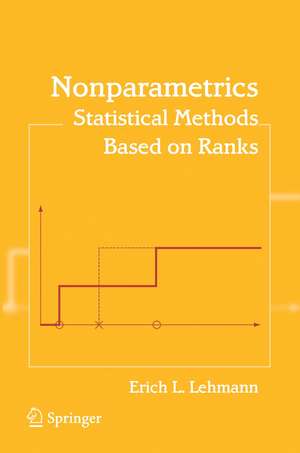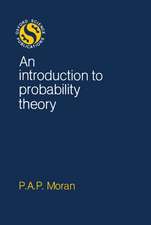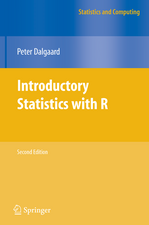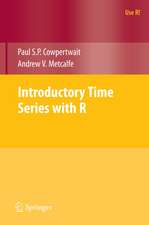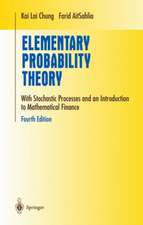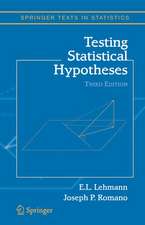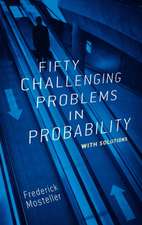Nonparametrics: Statistical Methods Based on Ranks
H.J.M. D'Abrera Autor Erich L. Lehmannen Limba Engleză Paperback – 27 iul 2006
Preț: 630.71 lei
Preț vechi: 788.39 lei
-20% Nou
Puncte Express: 946
Preț estimativ în valută:
120.70€ • 131.06$ • 101.39£
120.70€ • 131.06$ • 101.39£
Carte disponibilă
Livrare economică 01-15 aprilie
Livrare express 15-21 martie pentru 37.64 lei
Preluare comenzi: 021 569.72.76
Specificații
ISBN-13: 9780387352121
ISBN-10: 0387352120
Pagini: 463
Ilustrații: XVI, 463 p.
Dimensiuni: 155 x 235 x 22 mm
Greutate: 0.67 kg
Ediția:1st ed. 1975. Revised edition 2006
Editura: Springer
Colecția Springer
Locul publicării:New York, NY, United States
ISBN-10: 0387352120
Pagini: 463
Ilustrații: XVI, 463 p.
Dimensiuni: 155 x 235 x 22 mm
Greutate: 0.67 kg
Ediția:1st ed. 1975. Revised edition 2006
Editura: Springer
Colecția Springer
Locul publicării:New York, NY, United States
Public țintă
ResearchDescriere
Rank tests form a class of statistical procedures that have the advantage of great simplicity combined with surprising power. Since their development in the 1940s and 1950s, they have taken their place as strong competitors of the more classical normal theory methods. Rank tests apply only to relatively simple solutions, such as one-, tw0-, and s-sample problems, and testing for independence and randomness, but for these situations they are often the method of choice.
This reprint of a classic reference book describes these tests and the estimating procedures derived from them, and gives an account of their properties. Even though the field of rank tests has undergone little change, important new methodologies have sprung up that also serve the purpose of freeing statistics from the unrealistic model assumptions that so frequently invalidate its applications. All the tests discussed here are now available in a variety of statistical packages.
E.L. Lehmann is Professor of Statistics Emeritus at the University of California, Berkeley. He is a member of the National Academy of Sciences and the American Academy of Arts and Sciences, and the recipient of honorary degrees from the University of Leiden, The Netherlands and the University of Chicago. He is the author of Elements of Large-Sample Theory, Theory of Point Estimation, Second Edition (with George Casella), and Testing Statistical Hypotheses, Third Edition (with Joseph P. Romano).
This reprint of a classic reference book describes these tests and the estimating procedures derived from them, and gives an account of their properties. Even though the field of rank tests has undergone little change, important new methodologies have sprung up that also serve the purpose of freeing statistics from the unrealistic model assumptions that so frequently invalidate its applications. All the tests discussed here are now available in a variety of statistical packages.
E.L. Lehmann is Professor of Statistics Emeritus at the University of California, Berkeley. He is a member of the National Academy of Sciences and the American Academy of Arts and Sciences, and the recipient of honorary degrees from the University of Leiden, The Netherlands and the University of Chicago. He is the author of Elements of Large-Sample Theory, Theory of Point Estimation, Second Edition (with George Casella), and Testing Statistical Hypotheses, Third Edition (with Joseph P. Romano).
Cuprins
Rank Tests for Comparing Two Treatments.- Comparing Two Treatments or Attributes in a Population Model.- Blocked Comparisons for Two Treatments.- Paired Comparisons in a Population Model and the One-Sample Problem.- The Comparison of More Than Two Treatments.- Randomized Complete Blocks.- Tests of Randomness and Independence.
Caracteristici
Rank tests form a class of statistical procedures that have the advantage of great simplicity combined with surprising power. Since their development in the 1940s and 1950s, they have taken their place as strong competitors of the more classical normal theory methods. Rank tests apply only to relatively simple solutions, such as one-, tw0-, and s-sample problems, and testing for independence and randomness, but for these situations they are often the method of choice.
This reprint of a classic reference book describes these tests and the estimating procedures derived from them, and gives an account of their properties. Even though the field of rank tests has undergone little change, important new methodologies have sprung up that also serve the purpose of freeing statistics from the unrealistic model assumptions that so frequently invalidate its applications. All the tests discussed here are now available in a variety of statistical packages.
E.L. Lehmann is Professor of Statistics Emeritus at the University of California, Berkeley. He is a member of the National Academy of Sciences and the American Academy of Arts and Sciences, and the recipient of honorary degrees from the University of Leiden, The Netherlands and the University of Chicago. He is the author of Elements of Large-Sample Theory, Theory of Point Estimation, Second Edition (with George Casella), and Testing Statistical Hypotheses, Third Edition (with Joseph P. Romano).
Includes supplementary material: sn.pub/extras
This reprint of a classic reference book describes these tests and the estimating procedures derived from them, and gives an account of their properties. Even though the field of rank tests has undergone little change, important new methodologies have sprung up that also serve the purpose of freeing statistics from the unrealistic model assumptions that so frequently invalidate its applications. All the tests discussed here are now available in a variety of statistical packages.
E.L. Lehmann is Professor of Statistics Emeritus at the University of California, Berkeley. He is a member of the National Academy of Sciences and the American Academy of Arts and Sciences, and the recipient of honorary degrees from the University of Leiden, The Netherlands and the University of Chicago. He is the author of Elements of Large-Sample Theory, Theory of Point Estimation, Second Edition (with George Casella), and Testing Statistical Hypotheses, Third Edition (with Joseph P. Romano).
Includes supplementary material: sn.pub/extras
